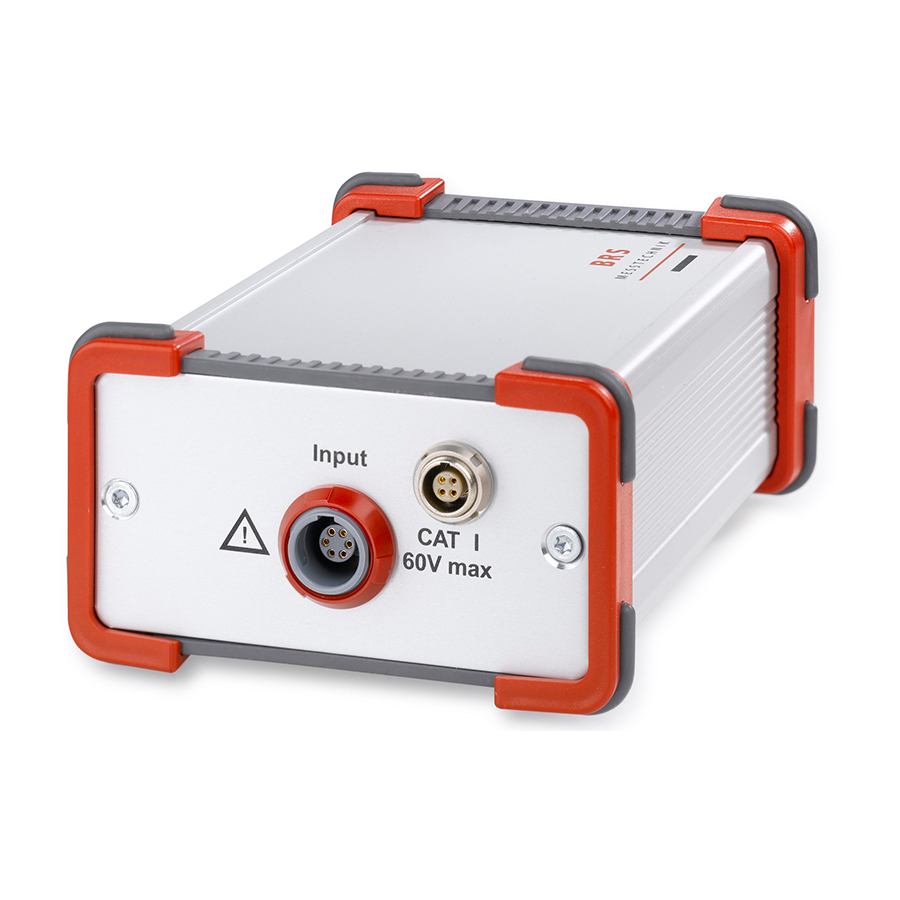
Table of Contents
Advertisement
Quick Links
Advertisement
Table of Contents

Summarization of Contents
1 Overview of Battery Impedance Meters
1.1 Short Description
Concise introduction to the BIM series battery impedance meters.
1.2 Versions
Comparison of different BIM models and their measurement capabilities.
1.3 Evaluation Functions
Advanced analysis features like spectral impedance and model approximation.
1.4 Selecting Languages
Instructions for changing the user interface language.
2 Operating Preparations for Battery Impedance Meters
2.1 Unpacking
Checklist of items included in the BIM instrument package.
2.2 Installing the Programs
Guide to installing the GUI software and necessary drivers.
2.3 Positioning of the Instrument
Recommendations for optimal placement and cooling.
2.4 Connecting Measurement Cables for Impedance and Voltage
Details on different cable types for connecting to batteries.
2.5 Connecting Measurement Cables for Temperature or Current (BIM2/3)
How to connect external sensors for temperature and current.
2.6 Connecting Digital Inputs/Outputs
Explanation of connecting digital I/O ports.
2.7 Connecting the Test Item
Procedure for connecting the battery under test using Kelvin connection.
3 Applications of Battery Impedance Measurement
Overview
Table illustrating applications of measurement parameters for battery properties and stages.
4 Measurement Functions
4.1 Functional Principle of Impedance Measurement
Explanation of the AC impedance measurement method and its components.
4.2 Overview
Description of GUI operation, settings, and remote control.
4.3 Settings
Configuration options for measurement parameters like range and frequency.
4.4 Battery Discharge During Extended Use
Considerations for prolonged measurements, including unipolar discharge and voltage monitoring.
5 Operation of Battery Impedance Meters
5.1 Measurement Function at Single Frequency
Performing individual impedance measurements at a specific frequency.
5.2 Spectral Measurement Function
Conducting spectral analysis and interpreting Nyquist plots.
Approximation
Utilizing the approximation feature for spectral data analysis.
Reference Curves
Saving, displaying, and comparing reference plots for quality control.
5.3 Measurement Function Capacity Test (BTC1 only)
Method for measuring battery capacity by controlled discharge.
5.4 Evaluation Function Tolerance Test
Performing tolerance tests against specified 'must' values.
5.5 Evaluation Function Diagnosis
Assessing battery health (SoH) and state of charge (SoC).
5.6 Measuring and Monitoring Voltage
Measuring terminal voltage and setting up monitoring limits.
5.7 Temperature and Current Measurements (BIM2, BTC1)
Connecting and using external sensors for temperature and current.
5.8 Single Measurements
Executing individual measurement cycles instead of continuous operation.
5.9 Instrument Configuration
Saving, activating, and managing instrument settings and setups.
6 Data Export from Battery Impedance Meters
6.1 Data Export via Text File (Log File)
Saving measurement data into a log file (BIMresults.log).
Exporting Values for Processing
Preparing data for import into table calculation or analysis software.
Archiving
Guidelines for storing measurement results for record-keeping.
6.2 Data Export via CSV Files
Generating data files in CSV format for easy data exchange.
8 Maintenance of Battery Impedance Meters
8.1 Cleaning
Procedures for safely cleaning the instrument.
8.2 Firmware Updates
Steps to update the instrument's firmware via software.
8.3 Recalibration
Recommendation for annual device recalibration by the manufacturer.
8.4 Help
Contact information for technical support and assistance.
11 Appendix: Recommendations for Battery Impedance Meters
11.1 Recommendations for Cable Running
Best practices for connecting measurement cables to ensure accuracy.
11.2 Recommendations for Selecting Frequencies
Guidance on choosing appropriate measurement frequencies, avoiding interference.

Need help?
Do you have a question about the BIM2 and is the answer not in the manual?
Questions and answers